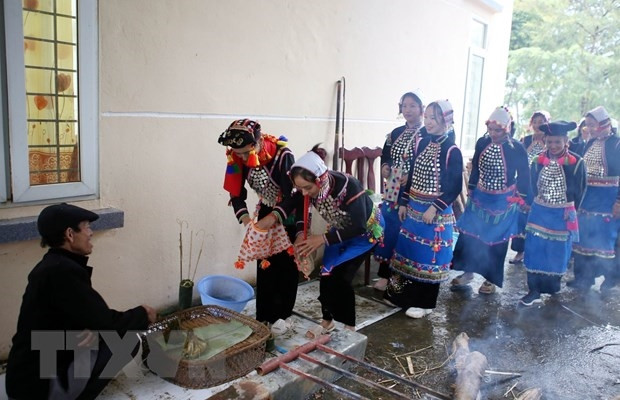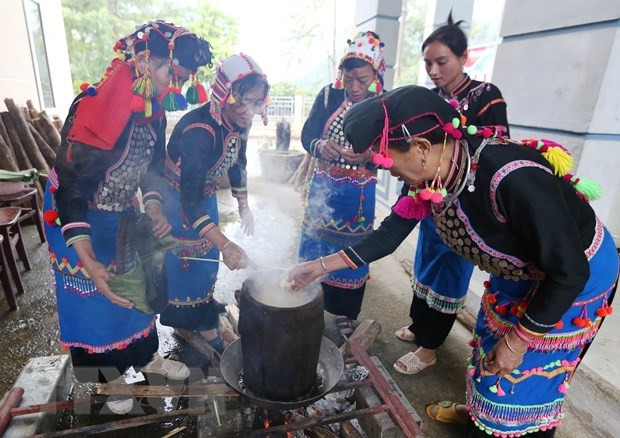Although being the smallest ethnic group in the community of 54 ethnic groups in Vietnam, the Si La people have a rich culture with its own unique characteristics, notably the traditional Tet holiday.

Families bring offerings to the head of the family's house to worship ancestors and gods during Tet. (Photo: Quy Trung/VNA)
Lai Chau is a mountainous border province with 20 ethnic groups living there, including the Si La. The Si La in Lai Chau have a long history of living along the Da River in Can Ho commune, Muong Te district.
Although being the smallest ethnic group in the community of 54 ethnic groups in Vietnam, the Si La people have a rich culture with its own unique characteristics, notably the traditional Tet holiday.
Currently, the Si La people of Lai Chau province mainly live in Muong Te district with nearly 150 households, more than 580 people, accounting for 0.13% of the province's population. In the past, the custom of celebrating Tet early was often known in the Mong ethnic community, but in Lai Chau there is also an ethnic group that celebrates Tet early every year, that is the Si La ethnic group in Can Ho commune, Muong Te district.
Every year, when peach blossoms (ky kha ve) bloom all over the mountainsides, the Sila people joyfully celebrate their traditional New Year, which in Sila is called "co to co o xi."
The Tet of the Si La people has many special features. The Kinh people, along with other ethnic groups, use the New Year's Eve as the year-end mark, but the Si La people celebrate Tet at the end of the harvest season. Therefore, depending on each place, whether the harvest season is early or late, they celebrate Tet, not necessarily at the same time.
The Sila celebrate Tet according to their clan. The first day of Tet must not coincide with the death day (burial day) of any ancestor (parent) of any family in the clan, nor with the days of the tiger or monkey. The Sila celebrate Tet for 3 days. The first day is called “va sí nhi” (pig slaughter day), the second day is called “chi xi to nhi” (drinking day) and the third day is called “che cho nhi” (ending day).
The day before Tet, the Sila people call it “cu pha ha nhi” (vegetable preparation day). People will clean the house, wash cooking utensils and prepare food and drinks for the Tet holiday. Women in the house will go out to catch crabs, fish and prepare a branch of sticky rice to worship their ancestors.
On Tet holiday, families wake up at the first cockcrow. The head of the house brings a flintlock gun to the door and fires a shot into the air to signal that Tet has arrived. Women in each family pound sesame and steam sticky rice. By about 4am, the sesame has been pounded and the steamed sticky rice has cooled, and the sound of pounding banh giay can be heard throughout the families.
On the first day of the New Year, every family slaughters a pig. Before the pig is slaughtered, it will be “celebrated” with banh troi and wine. The pig is placed on a bench, on the porch or on a high stone slab in the yard. The homeowner places 3 banh troi on the pig’s lips and pours a cup of wine into the pig’s mouth 3 times.
Then, lightly tap the pig's head with your hand and pray: "This year 100 kg, next year 200 kg, next year 300 kg." According to belief, doing so will help the next batch of pigs to be full, eat quickly, grow quickly, be healthy, and not be affected by disease.

Family members steam sticky rice to pound banh giay. (Photo: Quy Trung/VNA)
According to custom, the head of the family will start slaughtering the pig first, then the families in the clan will slaughter the pig at their house. That is also the time when the whole village is bustling with the sound of pigs squealing, the sound of knives and chopping boards, and the laughter of the families in the clan cheering and competing to see which family finishes slaughtering the pig first, because the Sila people believe that if a family finishes slaughtering the pig early, that year will be lucky in business.
However, depending on each family's conditions, they can slaughter large or small pigs. But the general rule is that it must be male pigs and traditional black pigs.
After slaughtering the pig, the Si La people take the liver to the oldest man in the house to see the family's fortune for that year. The two front legs, along with some intestines and lean meat, are given to the homeowner to use as an offering to their ancestors. The offerings are cooked in a small kitchen in the worship room - which is also the bedroom of the homeowner and his wife. The offering ceremony is performed immediately after the offerings are prepared.
That morning, families happily ate and drank at home. When the sun set, representatives of the families prepared the conditions for the ceremony according to the correct procedures and methods of the ethnic group. Mr. Hu Cha Hai, Si Thau Chai Village, Can Ho Commune, Muong Te District, shared: In addition to the pig, the offerings also included 2 squirrels (symbolizing agility), 2 crabs, 2 fish (to pray that the Si La people will have water to live wherever they go) and 2 rice cakes (ba pa) brought to the head of the family's house to worship their ancestors.
Representatives of the families in the clan sit together behind the clan leader, then the clan leader prays to the ancestors with the general idea: "The old year has passed, the new year has come, the descendants gather together to offer offerings to the ancestors. May the ancestors bless us with a new year full of abundance, warmth, food that cannot be eaten and drink that cannot be drunk..." After the offering ceremony, representatives of the families can attend a meal at the clan leader's house or can bring offerings home.
The second day is drinking day, couples bring a bottle of wine and a dried squirrel to their adoptive parents' and in-laws' houses to wish them a happy new year, visit them and eat and drink all day there.
The third day is the end of Tet, that morning, families wrap Chung cakes. The Si La people's Chung cakes are double Chung cakes - each cake is a pair of small, cylindrical packages. When the cakes are cooked, the homeowner chooses 1-2 to offer to the altar to worship the ancestors and inform them that Tet is over.
In the Sila family, the ancestral altar is rearranged after Tet. The parents are the ones to do it, and in case of illness, the eldest daughter-in-law will do it instead. Because according to the concept, the eldest daughter-in-law will be the head of the family in the future. The ancestral altar is placed in the corner of the house facing the setting sun, where the parents, the head of the family, sleep.
Previously, the Si La people did not organize entertainment activities due to their migratory lifestyle. With the attention, support, investment and encouragement of the State and Muong Te district, now during the New Year of the Si La people, cultural and sports exchange activities have been organized regularly and enthusiastically.
Mrs. Hu Co Xuan, Seo Hai village, Can Ho commune, Muong Te district excitedly said that the Si La people love art, playing and listening to musical instruments as an indispensable spiritual food in life. Therefore, the people have created many types of musical instruments of their own ethnic group such as flutes and bamboo lutes.
Mr. Kieu Hai Nam, Vice Chairman of Muong Te District People's Committee, said that for the Si La ethnic group in Muong Te district, in addition to the traditional Tet holiday, the Si La people still preserve and maintain the organization of new rice celebrations, village worship ceremonies, stream ghost worship ceremonies, songs and dances imbued with national identity.
However, some traditional cultural values, dishes and some folk songs and dances of the Sila people are gradually fading away. Therefore, in the coming time, Muong Te district will continue to pay attention and have policies and solutions to preserve the cultural values of the Sila people.
At the same time, the district encourages people to regularly maintain and organize religious, cultural and artistic activities; establish art troupes to preserve and conserve national culture.
According to VNA